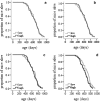Low resting metabolic rate is associated with greater lifespan because of a confounding effect of body fatness
- PMID: 25502004
- PMCID: PMC4262579
- DOI: 10.1007/s11357-014-9731-3
Low resting metabolic rate is associated with greater lifespan because of a confounding effect of body fatness
Abstract
A negative association between resting metabolic rate (RMR) and lifespan is the cornerstone of the rate of living and free-radical damage theories of aging. Empirical studies supporting a negative association of RMR to lifespan may arise from the correlation between RMR and both daily energy expenditure (DEE) and thermoregulatory activity energy expenditure (TAEE). We screened 540 female mice for higher and lower DEE and measured RMR in the resulting 324 (60 %). We then selected 92 mice in which there was no link between residual from the regression of RMR against body mass (BM) and residual of DEE against BM to separate the effects of these traits. Lifespan was not significantly related to body mass, DEE and TAEE, but significantly negatively related to RMR. Fat-free mass (FFM) and fat mass (FM) were both significantly positively related to RMR. After removing the effect of FFM on RMR, the association between RMR and lifespan remained significantly negative; however, after statistically removing the effect of FM on RMR, the significant association between RMR and lifespan disappeared. We conclude that the negative association between RMR and lifespan is primarily due to the effect of FM, with FM positively related to both RMR and mortality and hence RMR negatively to lifespan. In 40 additional screened mice, greater FM was also associated with greater oxidative damage to DNA.
Figures





Similar articles
-
Body size, energy metabolism and lifespan.J Exp Biol. 2005 May;208(Pt 9):1717-30. doi: 10.1242/jeb.01556. J Exp Biol. 2005. PMID: 15855403 Review.
-
Relationship between energy expenditure and visceral fat accumulation in obese women submitted to adjustable silicone gastric banding (ASGB).Int J Obes Relat Metab Disord. 1995 Apr;19(4):227-33. Int J Obes Relat Metab Disord. 1995. PMID: 7627245 Clinical Trial.
-
Living fast, dying when? The link between aging and energetics.J Nutr. 2002 Jun;132(6 Suppl 2):1583S-97S. doi: 10.1093/jn/132.6.1583S. J Nutr. 2002. PMID: 12042467 Review.
-
Does circulating leptin play a role in energy expenditure?Nutrition. 2019 Apr;60:6-10. doi: 10.1016/j.nut.2018.08.015. Epub 2018 Sep 7. Nutrition. 2019. PMID: 30508765
-
Effects of habitual physical activity on the resting metabolic rates and body compositions of women aged 35 to 50 years.J Am Diet Assoc. 2001 Oct;101(10):1181-8. doi: 10.1016/S0002-8223(01)00289-9. J Am Diet Assoc. 2001. PMID: 11678489
Cited by
-
Effect of basal metabolic rate on lifespan: a sex-specific Mendelian randomization study.Sci Rep. 2023 May 12;13(1):7761. doi: 10.1038/s41598-023-34410-6. Sci Rep. 2023. PMID: 37173352 Free PMC article.
-
Association Between Basal Metabolic Rate and All-Cause Mortality in a Prospective Cohort of Southern Chinese Adults.Front Physiol. 2022 Jan 4;12:790347. doi: 10.3389/fphys.2021.790347. eCollection 2021. Front Physiol. 2022. PMID: 35058799 Free PMC article.
-
Oxidative Damage Does Not Occur in Striped Hamsters Raising Natural and Experimentally Increased Litter Size.PLoS One. 2015 Oct 27;10(10):e0141604. doi: 10.1371/journal.pone.0141604. eCollection 2015. PLoS One. 2015. PMID: 26505889 Free PMC article.
-
The metabolic costs of meiotic drive.Proc Biol Sci. 2025 Jul;292(2050):20250779. doi: 10.1098/rspb.2025.0779. Epub 2025 Jul 2. Proc Biol Sci. 2025. PMID: 40592454 Free PMC article.
-
Energetics of Aging and Frailty: The FRADEA Study.J Gerontol A Biol Sci Med Sci. 2016 Jun;71(6):787-96. doi: 10.1093/gerona/glv182. Epub 2015 Oct 13. J Gerontol A Biol Sci Med Sci. 2016. PMID: 26463762 Free PMC article.
References
-
- Barja G, Cadenas S, Rojas C, Perez-Campo R, Lopez-Torres M. Low mitochondrial free radical production per unit O2 consumption can explain the simultaneous presence of high longevity and aerobic metabolic rate in birds. Free Radic Res. 1994;21(5):317–328. doi: 10.3109/10715769409056584. - DOI - PubMed
-
- Beckman KB, Ames BN. The free radical theory of aging matures. Physio Rev. 1998;78(2):547–581. - PubMed
Publication types
MeSH terms
Grants and funding
LinkOut - more resources
Full Text Sources
Other Literature Sources
Medical
